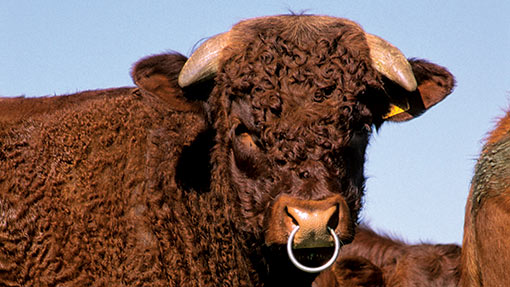Easy calving makes Saler breed a popular suckler choice

While most beef breeds are experiencing a reduction in demand for breeding bulls the Salers is bucking the trend.
Monitoring of the official BCMS figures by the Salers Cattle Society shows more suckled calf producers are buying Salers bulls.
For the 10 years from 2005 to 2014, the use of the Salers bulls grew by 34%, versus a decline of 18% in the use of beef sires overall, official BCMS data shows.
Although the breed is proving increasingly popular as a herd sire with the job of producing replacement females, pedigree breeders say a high percentage of Salers bull buyers are attracted by the breed’s reputation for easy calving.
“When suckler margins are tight, getting a live calf becomes more important than ever,” says Terence Pye, who is a partner in the Rigel herd of Salers at Yarm, North Yorkshire.
“In over 20 years with these cattle we’ve had so few assisted calvings, I can remember every one. When a Salers female starts to calve you just let them get on with it – and that’s what’s driving the demand for bulls.”
Mr Pye undertakes the monitoring of BCMS data on behalf of the breed society. “While some of the major beef breeds have suffered significant declines in the demand for bulls over the past decade, sales of Salers bulls has been steadily increasing at about 5% a year since 2011.
“And the majority of our buyers want a Salers bull for ease of calving. This year we’ve even had triplets born with no assistance.”
Pelvic area measurement is another key issue among Salers breeders. “We are encouraging breeders to be vigilant in maintaining pelvic area measurements to ensure the trait is maintained in future breeding animals.
“In our herd we measure the pelvic area of our young bulls rather than the heifers. The bulls will have a far greater positive impact on the breed, because of the much larger numbers of daughters they’ll breed compared to the heifers. Pelvic area is a strongly heritable trait, so selecting breeding bulls with a large pelvic area will lead to larger pelvic areas in their daughters,” explains Mr Pye.
Welsh beef and sheep producer Wyn Evans of Llanwddyn, Powys, is now running a virtually purebred herd of 100 Salers cattle after grading up through his Welsh Blacks. He uses a Charolais as the top-cross to produce strong stores sold at about 10 months old at Welshpool market.
The spring-born calves are weaned at housing in October and wintered on a forage diet of 80% silage and 20% straw, plus 3kg a head a day of concentrate. This year’s stores that were sold in spring averaged 427kg and realised an average of £1,063 for 80 head.
“Calves out of the Salers females are always quickly up on their feet and sucking. We calve our heifers at two years old and never have any problems.
“And when we sell them as stores their consistency and uniformity is a real bonus. They certainly turn heads when we get them into the market,” says Mr Evans, who reckons many Salers bulls now have the conformation to match the most popular continental breeds.
“And the cows wear well. We’ve some cows still breeding at 14 years old,” adds Mr Evans.
With suckled calf margins under increasing pressure, the efficiency of the suckler dam is ever more important. But while the Salers is no newcomer to the UK, having arrived here more than 25 years ago, the breed is now attracting more supporters impressed by its reputation for hardiness, milking ability and easy calving.
Predominantly red-coated – although black Salers also occur – the breed is also noted for its frame and scale. They are traits that north Wales farmer Evan Lloyd from Harlech was determined to make the most of when he first began to use a Salers bull on his Welsh Black cows.
“I wanted to produce suckler females that would cross well with the Welsh Black to retain the breed’s qualities, but also give the scale and frame. I needed a cross-bred dam that would cross well with the Charolais. And introducing the Salers into the herd has done precisely that,” says Mr Lloyd.
His autumn calving herd relies on the sale of strong Charolais-sired stores sold at about 13 months old and out of Salers cross Welsh Black dams.
“I’ve got calves that have the frame to take the growth and the conformation qualities of the Charolais and that produces really strong stores. This autumn our stores have sold well. The heaviest bunch averaged 565kg and £1,190, while even the lighter stores were averaging 490kg and £1,015.”
The replacement Salers-cross heifers, which are outwintered until they calve for the first time, have impressed Mr Lloyd with their easy calving and in particular their milk yield.
“They have very tidy udders and give a lot of milk – in fact sometimes they almost have too much,” says Mr Lloyd.
Breed society secretary Liz Wilde says the Salers is one of the most pure of all the European breeds. “It means farmers get the maximum impact of hybrid vigour when the Salers is part of a cross-bred suckler dam.”
Read more on how two suckler producers are maximising profits
